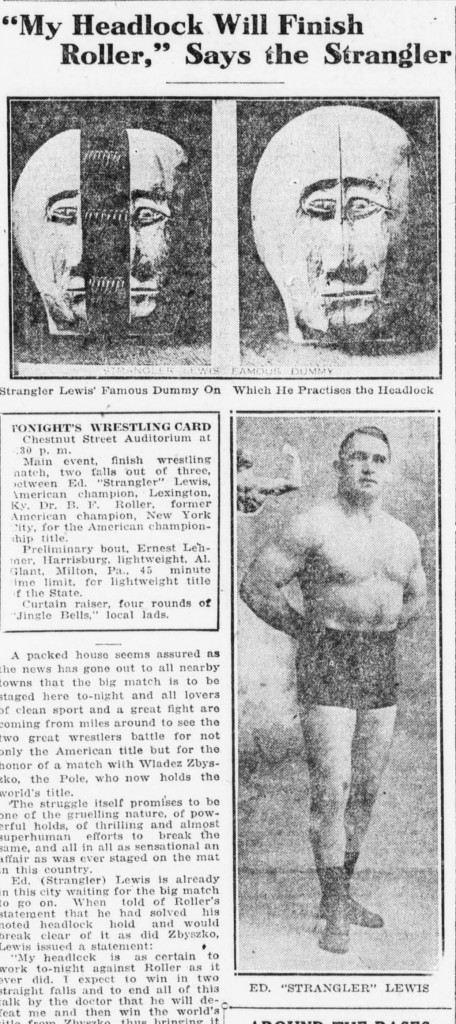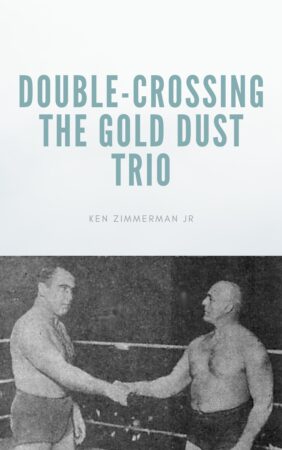Ed “Strangler” Lewis’ Mirtinas galvos užraktas
Vedantis į jo sausį 24, 1921 titulo rungtynės su buvusiu pasaulio čempionu Earlu Caddocku, Pasaulio sunkiasvorių imtynių čempionas Ed “Strangler” Manoma, kad Lewisas sužeidė du ankstesnius varžovus, Wladek Zbyszko ir Joe Stecher, su savo galvos apdangalu. Lewisas naudojo galvos užraktą, kad numestų priešininką ant grindų. Zbyszko buvo išmuštas beprasmis, when his head hit the mat. Stecher suffered an injured shoulder during his world title loss to Lewis in December 1920.
Lewis’ manager Billy Sandow was an excellent promoter. One of his promotion tactics leading into the Caddock match was to feed a story to the New York newspapers about Caddock trying convince the New York State Athletic Commission to ban the headlock in New York.

“Strangler” Lewis and his training dummy
The story was false but it helped to push the headlock as a deadly, match-ending hold. Craddock denied trying to have the hold banned, which was true. He also told the newspapers he intended to use his toehold on Lewis.
During the match, Lewis again used the hold to throw Caddock several times and finished the match by slamming Craddock to the mat so hard he was knocked unconscious. Other than being a little groggy, Caddock was uninjured. Tačiau, the fans began yelling, “No more headlocks” as Lewis left the arena.
A couple days later, the Kansas City Police had to protect Lewis from an angry crowd, who were protesting Lewis’ use of the headlock in another match.
Sandow’s publicity worked too well. With all the publicity, the New York State Athletic Commission banned the use of the hold in New York. Sandow had gotten Lewis’ hold over but if Lewis couldn’t use it, they would have trouble drawing big crowds for Lewis’ atitikmuo.
Lewis had a wooden dummy head, which had two large automobile springs in between the two wood pieces. Lewis was said to squeeze the dummy head daily, which developed his powerful headlock.
The publicity was extremely effective. The headlock isn’t a valid technique for championship wrestling or grappling of any kind. You are giving up your back, while standing. Even after taking the other wrestler to the ground, they are still on your back. Once they work free, you are in an extremely poor defensive position.
The headlock can be a painful hold but you can’t cut off the blood flow to brain unless you catch an angle for the bulldog headlock, which is extremely rare. You normally won’t get a submission and your opponent will take your back at some point.
Lewis was legitimately one of the greatest wrestlers in American history and could beat his opponents at will. When he used the headlock, it was a clear signal the match was a cooperative work not an actual contest.
All the previous matches were prearranged exhibitions and none of his opponents was really injured from the headlock. In trying to build up excitement for title matches, they accidentally killed the golden goose in New York. They couldn’t let the New York State Athletic Commission know they were cooperating with each other, so they had to live with the ruling until they could change the narrative.
You can leave a comment or ask a question about this or any post on my Facebook page.
Sources: Niujorkas Tribune ", Sausis 22, 1921 edition, p. 11 and January 25, 1921 edition, p. 13. Great Falls Tribune, Sausis 28, 1921 edition, p. 6
Pin It

